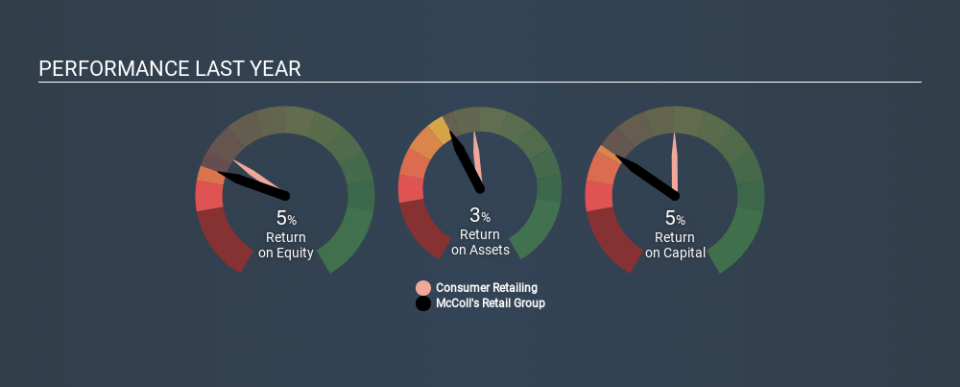Is McColl's Retail Group plc (LON:MCLS) Struggling With Its 5.4% Return On Capital Employed?

Today we'll evaluate McColl's Retail Group plc (LON:MCLS) to determine whether it could have potential as an investment idea. To be precise, we'll consider its Return On Capital Employed (ROCE), as that will inform our view of the quality of the business.
First up, we'll look at what ROCE is and how we calculate it. Next, we'll compare it to others in its industry. Last but not least, we'll look at what impact its current liabilities have on its ROCE.
What is Return On Capital Employed (ROCE)?
ROCE is a metric for evaluating how much pre-tax income (in percentage terms) a company earns on the capital invested in its business. Generally speaking a higher ROCE is better. In brief, it is a useful tool, but it is not without drawbacks. Renowned investment researcher Michael Mauboussin has suggested that a high ROCE can indicate that 'one dollar invested in the company generates value of more than one dollar'.
So, How Do We Calculate ROCE?
Analysts use this formula to calculate return on capital employed:
Return on Capital Employed = Earnings Before Interest and Tax (EBIT) ÷ (Total Assets - Current Liabilities)
Or for McColl's Retail Group:
0.054 = UK£15m ÷ (UK£506m - UK£229m) (Based on the trailing twelve months to May 2019.)
So, McColl's Retail Group has an ROCE of 5.4%.
View our latest analysis for McColl's Retail Group
Is McColl's Retail Group's ROCE Good?
ROCE is commonly used for comparing the performance of similar businesses. Using our data, McColl's Retail Group's ROCE appears to be significantly below the 6.7% average in the Consumer Retailing industry. This performance could be negative if sustained, as it suggests the business may underperform its industry. Setting aside the industry comparison for now, McColl's Retail Group's ROCE is mediocre in absolute terms, considering the risk of investing in stocks versus the safety of a bank account. It is possible that there are more rewarding investments out there.
We can see that, McColl's Retail Group currently has an ROCE of 5.4%, less than the 12% it reported 3 years ago. So investors might consider if it has had issues recently. You can see in the image below how McColl's Retail Group's ROCE compares to its industry. Click to see more on past growth.
When considering this metric, keep in mind that it is backwards looking, and not necessarily predictive. ROCE can be deceptive for cyclical businesses, as returns can look incredible in boom times, and terribly low in downturns. This is because ROCE only looks at one year, instead of considering returns across a whole cycle. Future performance is what matters, and you can see analyst predictions in our free report on analyst forecasts for the company.
McColl's Retail Group's Current Liabilities And Their Impact On Its ROCE
Current liabilities are short term bills and invoices that need to be paid in 12 months or less. Due to the way ROCE is calculated, a high level of current liabilities makes a company look as though it has less capital employed, and thus can (sometimes unfairly) boost the ROCE. To counter this, investors can check if a company has high current liabilities relative to total assets.
McColl's Retail Group has total assets of UK£506m and current liabilities of UK£229m. Therefore its current liabilities are equivalent to approximately 45% of its total assets. McColl's Retail Group's ROCE is improved somewhat by its moderate amount of current liabilities.
What We Can Learn From McColl's Retail Group's ROCE
Despite this, its ROCE is still mediocre, and you may find more appealing investments elsewhere. Of course, you might find a fantastic investment by looking at a few good candidates. So take a peek at this free list of companies with modest (or no) debt, trading on a P/E below 20.
If you are like me, then you will not want to miss this free list of growing companies that insiders are buying.
If you spot an error that warrants correction, please contact the editor at editorial-team@simplywallst.com. This article by Simply Wall St is general in nature. It does not constitute a recommendation to buy or sell any stock, and does not take account of your objectives, or your financial situation. Simply Wall St has no position in the stocks mentioned.
We aim to bring you long-term focused research analysis driven by fundamental data. Note that our analysis may not factor in the latest price-sensitive company announcements or qualitative material. Thank you for reading.

